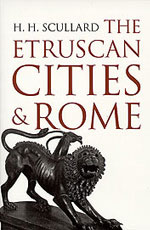The Etruscans
A little about their civilization
(From The National Geographic Magazine Vol.173 no.6 June 1988, all rights reserved)
|
The areas of expansion of the Etruscan civilization. The names of the principal settlements are underlined. The Etruscan civilization dominated the whole area of central Italy before the advent of the Roman. The origin of this people is still today mysterious , having come up to us only illegible fragments of their writing-system. However we have testimonies of their big commercial, industrial, agricultural and engineering ability. Etruscan farmers, merchants, miners and engineers built for the first time in history the sewerage and reclaimed the swampy lowland that subsequently became the center of Rome. They were also able to foresee the future interpreting the direction of the lightning or observing the interiors of previously sacrificed animals but, as the Greek farmers of the south Italy, they ignored for too much time the ascent of the power of Rome that, after 130 years of continuous attacks to their city-state, called 'Lucumonie', put the word end to their civilization. The last Etruscan city to capitulate was Velzna (now called Orvieto) in the 265 AC |
Ca 900-750 AC - Villanovan
cultures in Italy. From their hamlets Etruscan cities grow. 750-600 AC - Greek colonies exert strong influence over newly urbanized Etruscans. 616 AC - Tarquinius Priscus becomes first Etruscan to rule Rome. 550 AC - Founding of cities in Po Valley and expansion into Campania. 535 AC - Control of Corsica heralds greatest extent of Etruscan influence. 509 AC - Fall of Tarquin dynasty in Rome marks the beginning of Etruscan decline. 396 AC - Sacking of Veio, after ten-year siege, end's city's long conflict with Rome. 265 AC - Capitulation of Velzna, last Etruscan city to be subdued to Rome. 90 AC - After centuries of decline, Etruscans become Roman citizens. OTHER BOOKS:
- Etruscan Art (World of Art) |
| If you want to know about it visit this sites: |
| The Etruscans: https://www.agmen.com/etruscans |
| The Etruscans VIII�-beginnings III�sec. AC: https://194.243.196.2/puam/comgr/stor/storia/celu02.htm |
| The Etruscans, a revealed mystery: https://www.isa.it/tuscia/storia/etrus.htm |
| The Etruscans world : https://users.iol.it/agmen/index.htm |


